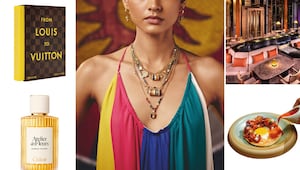
Exploring the different colors of Pride and their deeper meanings
These Pride flags are your guide to understanding the rich diversity within the community.

Rainbow flags are more than just vibrant symbols; they are a guide to understanding the LGBTQIA+ community. Each colour chosen for these flags represents different aspects and diversities within the community, coming together to celebrate the wide spectrum of identities. Let's delve into the meanings behind these colours to gain a deeper appreciation for the rich diversity within the community.
Umbrella Flags
Gilbert Baker Pride Flag

American artist/activist Gilbert Baker gave the gay movement a new symbol (previously it was a pink triangle) in 1978—the Rainbow Flag.
Traditional Gay Pride Flag

Due to some manufacturing woes, Gilbert Baker’s original eight-colour flag was pared down. Presenting: the iconic six-colour flag of today sans the
hot pink and turquoise.
Queer Pride Flag

We love a flag that embraces every facet of queerness—pink and blue symbolise same-sex attraction; orange and green for non-conformity.
Philadelphia Pride Flag

In 2017, the queer community opened up to include people of colour with the Philadelphia City Council adding black and brown stripes to the traditional gay pride flag.
Sexual Orientation Flags
Lesbian Pride Flag

Among the many iterations of the Lesbian Pride Flag, this 2018 design has been a community-favourite. It celebrates femininity through red, pink, and orange.
Trans-Inclusive Gay Men’s Pride Flag

The second version of the Gay Men’s Pride Flag flaunts blue, green, and purple, as opposed to the original that excluded non-cisgender gay men.
Bisexual Pride Flag

In 1998, bisexuality activist Michael Page designed this flag. The pink, blue, and purple narrate stories of same-sex attraction, heterosexual attraction, and their intertwining to showcase attraction to both.
Pansexual Pride Flag

Pansexuality is all about being attracted to people regardless of their gender. Created in 2010, this vibrant flag features pink for attraction to females, blue for males, and yellow for everyone beyond the binary.
Gender Identity & Gender Expression Flags
Transgender Pride Flag

In 2000, American transgender activist Monica Helms unveiled the trans flag. The pink and blue are traditional gender colours while white celebrates intersex and non-binary individuals.
Non-Binary Pride Flag

A beacon for those beyond the gender binary, embracing multiple or mixed identities, and the ones proudly genderless, the 2014 flag embodies the entire spectrum of gender identity.
Intersex Pride Flag

Morgan Carpenter, an Intersex activist, created this to celebrate those born with unique sex traits. The gender-neutral hues with the circle represents completeness.
Genderfluid Pride Flag

In 2013, JJ Poole created a flag to celebrate gender fluidity. With pink stripes for femininity, blue for masculinity, purple for a mix, white for all genders, and black for agender, the flag empowers all.
Progress Pride Flag

Artist Daniel Quasar gave the pride flag a makeover in 2018—white, pink, and light blue triangles for the trans community; black and brown triangles for HIV/AIDS victims of 1980s and '90s crises.
Intersex-Inclusive Progress Pride Flag

Progress Pride Flag This is the most updated LGBTQ+ flag there is. The 2021 addition of the yellow triangle and purple ring were symbolic of the inclusion of the intersex community.
Drag Pride Flag

Created by drag entertainer Veranda L’Ni in 2016, the drag pride flag’s purple is about love for drag, blue for expression and loyalty, and white for a blank canvas for the performers.
Straight Ally Flag

Allies can respectfully use various flags to support queers. However, the specifically flag with an 'A' on a black and white background for nonqueer allies.
Asexual Pride Flag

In 2010, the asexual community got its own flag—there’s black for sexuality, grey for demisexuality, white for allies, and purple for the community.
Demisexuality Pride Flag

This one is for those who feel sexual attraction only after an emotional bond. Rejecting the binaries, it celebrates forming connections with love interests.
Polyamory Pride Flag

Designed by American artist Jim Evans in 1995, it celebrates consensual emotional connections with multiple partners. Updated in 2022, the white chevron stands for hope and the heart represents love.
Polysexual Pride Flag

This flag represents attraction to many (but not all) genders. Blue is for attraction to men, pink for women, and green for those outside of the binary.
Genderqueer Pride Flag

Musician Marilyn Roxie’s flag is for those rejecting traditional genders. Lavender is for androgyny and queer identities, white for agender, green for non-binary gender expressions.
Agender Pride Flag

This 2014 flag is for those who are gender-neutral. Black and white show gender absence, grey is for semi-genderless, and green reps non-binary.
Bigender Flag

Representing people with two genders, which occur at the same time or varied times, this flag extends inclusion of non-binary gender identities.
Demigender Pride Flag

A flag for those who do not conform to either a gender identity or to the concept of gender entirely.
Intersectionality Flags
Pride of Africa Flag

This is the first pan-African flag that represents diversity and empowerment! Inspired by all 54 countries on the continent, this flag was launched in 2019 at the Johannesburg Pride.
Queer People of Colour Pride Flag

The flag rose to prominence in 2020 during the Black Lives Matter movement. The clenched fist represents the QPOC’s (Queer People of Colour) solidarity with those fighting for racial equality.
Two-Spirit Pride Flag

The flag, honouring some indigenous Americans who identify as two spirit, goes beyond traditional gender roles. The circle symbolises the blend of identities into a unique gender while, the rainbow background celebrates modern queer communities.
This article originally appeared in Cosmopolitan India, May-June 2024 print issue.
Image credit: Shradha Swaminathan
Lead image credit: Pexels
Also read: #PrideReads: Add these new LGBTQ+ book releases to your June reading list
Also read: #PrideMonth: Homegrown labels that are all about inclusivity and genderless fashion
more from Life

The coolest restaurants across India that deserve to be on your foodie radar

10 queer shows and movies that bring the same messy, steamy heat as 'Heated Rivalry'

Why 'Heated Rivalry' has everyone hot, bothered, and obsessed

Regal revivals, fashion shake-ups, and everything new we’re obsessing over this month

When is the new season of 'Euphoria' out? Plus 5 things we know about it

How Aldo became one of the hottest footwear and accessories brands in India

Four photographers on why a good photograph is more than just a good camera

Why writers are side-eyeing ChatGPT (even as they keep using it)

5 party dress trends you'll see everywhere this festive season and how to style them for your upcoming events

Have you found true love this cuffing season or are you just “winter coating” for the holidays?
